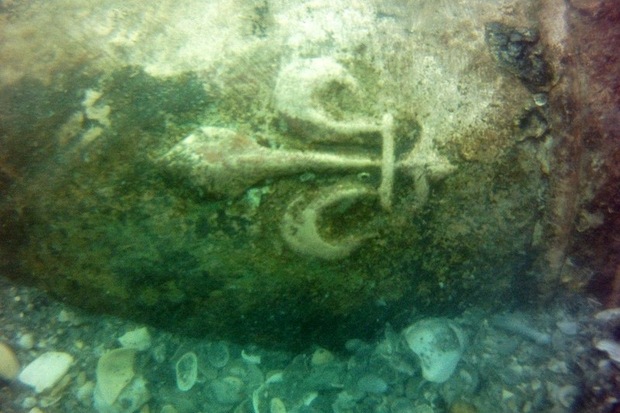Did a Conspiracy Rob These Treasure Hunters of Millions of Dollars' Worth of Florida Shipwreck Artifacts?

A maritime salvage company of "treasure hunters" discovered some of the United States' oldest European artifacts in shipwrecks near Cape Canaveral in 2016. Now, the finders are suing the state of Florida for millions of dollars in damages, alleging a conspiracy of sorts between the governments of France and Florida to deprive the company of its share of the spoils.
Global Marine Exploration (GME) alleges that some Florida state officials misused their knowledge of the location of the artifacts — including several 16th century cannons, estimated to be worth $1 million each — and colluded with France to help that nation take control of the shipwreck sites and artifacts.
Between May and June of 2016, GME's divers discovered the cannons and other debris from three colonial-era shipwrecks buried beneath a few feet of sand on the shallow. [20 Most Mysterious Shipwrecks Ever]
The company was operating using six underwater-exploration permits for the Cape Canaveral area that the state of Florida had approved.
But after the company reported its find to state officials, the shipwreck sites and artifacts became the subject of a legal dispute between GME and the nation of France, which was supported in its legal claim by the state of Florida.
Earlier this year, a judge in a U.S. federal district court ruled that the shipwrecks and any artifacts they contained belonged to France, because the ships had been part of the expeditions to Florida in 1562 and 1565, which were funded by the French government of the day and led by the explorer Jean Ribault.
GME's research suggests that the ships were Spanish, not French, and that GME would have been able to prove the ships were Spanish if the state of Florida had issued underwater-recovery permits to let GME recover some of the artifacts for identification.
Get the world’s most fascinating discoveries delivered straight to your inbox.
Treasure hunters
The shipwreck yielded several rare treasures, including three large and ornate bronze cannons, 19 smaller iron cannons, 12 anchors, and other stone and metal artifacts, Live Science previously reported.
While the bronze cannons alone could be worth $1 million each, the greatest find was a marble monument, engraved with the coat of arms of the king of France. The artifact matched descriptions of a monument erected at the early French colony at Fort Caroline, near what is now Jacksonville, Florida.
The lawsuit contends the cannons and monument were looted from the Fort Caroline colony, which was destroyed in a Spanish raid and massacre in September 1565.
If that's the case, the artifacts were on Spanish ships, bound probably for Cuba, when they sank. (Spain has made no claim on the Cape Canaveral shipwrecks, and Spanish ships might have been privately owned, meaning the Spanish government wouldn't necessarily have claims to them.)
The U.S. court, however, decided against GME and in favor of France, which contended that the shipwrecks found by GME were part of French naval officer Ribault's "lost fleet" of ships, including his flagship La Trinité. The lost fleet sank during a storm off the coast of Florida in October 1565, a few weeks after the Spanish raid on Fort Caroline.
The court ruled that under U.S. law the shipwrecks and artifacts were French government vessels and still belonged to the nation of France after more than 400 years on the seafloor – and so they could not be salvaged without French permission.
In a new lawsuit against the state of Florida filed on Oct. 15, GME did not seek to overturn that ruling. But GME CEO Robert Pritchett declined to rule out an appeal against that earlier decision.
"GME showed the court many times that it could not be a French vessel," Pritchett told Live Science in an email. "And the judge had no jurisdiction to say it was French."
Disputed bounty
GME is suing the state of Florida for up to $110 million, alleging that state officials misused the company's intellectual property — the location of the shipwreck artifacts — after GME reported its finds to them.
In its latest court filing, GME alleged that state officials misused their knowledge in order to investigate the shipwreck independently, then colluded with French officials to gain control of the seafloor sites and artifacts — thereby depriving GME of "investment-backed expectations in undertaking salvage operations."
Pritchett said that the state of Florida wants to put private "treasure-hunting" firms like GME out of business and leave all the underwater archaeology to be carried out by state-subsidized and academic maritime archaeology programs. Those are now likely to recover artifacts on the Cape Canaveral shipwreck sites on behalf of France.
"The only reason the region has any archaeological knowledge is because of treasure hunters that do it the right way," Pritchett said: "It sure ain't from the state or federal archaeologists — they have no field experience."
The state of Florida declined to speak to Live Science about the latest claim for damages brought by GME; a spokesperson for the state said in an email that Florida's Department of State did not comment on pending litigation.
For now, the valuable cannons, monument and other artifacts are thought to remain where they have lain for hundreds of years, a few feet beneath the sandy seafloor in relatively shallow water just off of Cape Canaveral.
Pritchett told Live Science that he wasn't aware of any efforts by France or Florida to recover the artifacts, but the area is closed off for underwater operations over the winter, during Florida's right whale breeding season.
Originally published on Live Science.
Tom Metcalfe is a freelance journalist and regular Live Science contributor who is based in London in the United Kingdom. Tom writes mainly about science, space, archaeology, the Earth and the oceans. He has also written for the BBC, NBC News, National Geographic, Scientific American, Air & Space, and many others.


